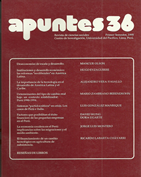Determinants of the exchange rate under a stabilizing context
DOI:
https://doi.org/10.21678/apuntes.36.414Keywords:
Peru, exchange rateAbstract
The reason for understanding the evolution of the real exchange rate lies in the central importance of this variable to the country's development, especially in the growth of the tradable sector.
This research analyzes the development of the real exchange rate under the 1990-94 Peruvian Stabilization Program from a dynamic econometric perspective. The resulting model is subjected to a series of tests.
The overall evidence supports the argument that the real exchange rate rejects the hypothesis of the Purchasing Power Parity theory (PPP), in the short, as well as long terms. Therefore, it is wrong to use the PPP to explain the evolution of the real exchange rate. This fact increases the need to find a universally valid alternative theoretical approach.
The results in the long run show that the behavior of the differential between domestic interest rates and foreign rates in dollars was the main cause of the changes in the rea7 exchange rate, the evolution of the fiscal deficit did not have a significant impact, while the policy of intervention did not achieve the desired effects.
Downloads
Downloads
Published
How to Cite
Issue
Section
License
Apuntes publishes all its articles and reviews under a Creative Commons Attribution (CC BY 4.0) license with the objective of promoting academic exchange worldwide. Therefore, articles and book reviews can be distributed, edited, amended, etc., as the author sees fit. The only condition is that the name of the author(s) and Apuntes. Revista de Ciencias Sociales (as the publisher) be cited.



.jpg)
